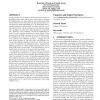Free Online Productivity Tools
i2Speak
i2Symbol
i2OCR
iTex2Img
iWeb2Print
iWeb2Shot
i2Type
iPdf2Split
iPdf2Merge
i2Bopomofo
i2Arabic
i2Style
i2Image
i2PDF
iLatex2Rtf
Sci2ools
ICS
2010
Tsinghua U.
2010
Tsinghua U.
InterferenceRemoval: removing interference of disk access for MPI programs through data replication
As the number of I/O-intensive MPI programs becomes increasingly large, many efforts have been made to improve I/O performance, on both software and architecture sides. On the software side, researchers can optimize processes' access patterns, either individually (e.g., by using large and sequential requests in each process), or collectively (e.g., by using collective I/O). On the architecture side, files are striped over multiple I/O nodes for a high aggregate I/O throughput. However, a key weakness, the access interference on each I/O node, remains unaddressed in these efforts. When requests from multiple processes are served simultaneously by multiple I/O nodes, one I/O node has to concurrently serve requests from different processes. Usually the I/O node stores its data on the hard disks, and different process accesses different regions of a data set. When there are a burst of requests from multiple processes, requests from different processes to a disk compete with each othe...
| Added | 29 Sep 2010 |
| Updated | 29 Sep 2010 |
| Type | Conference |
| Year | 2010 |
| Where | ICS |
| Authors | Xuechen Zhang, Song Jiang |
Comments (0)

